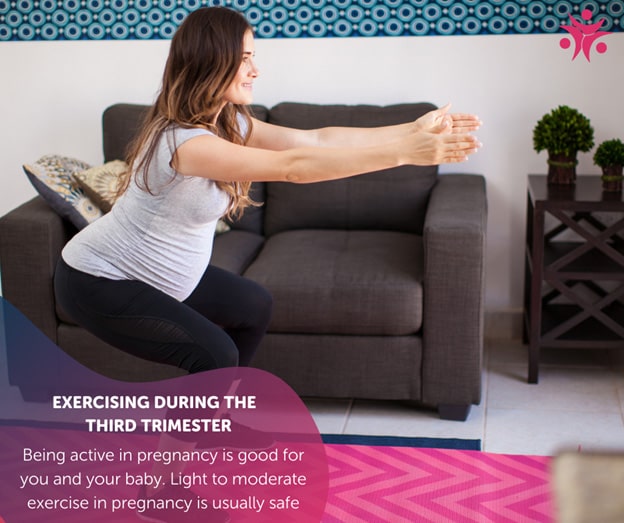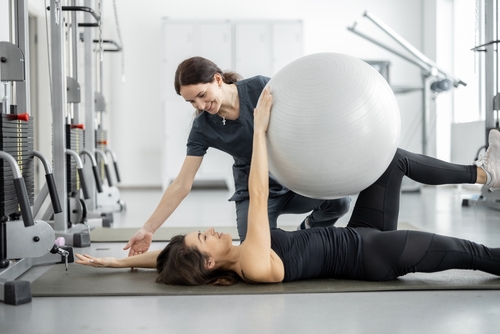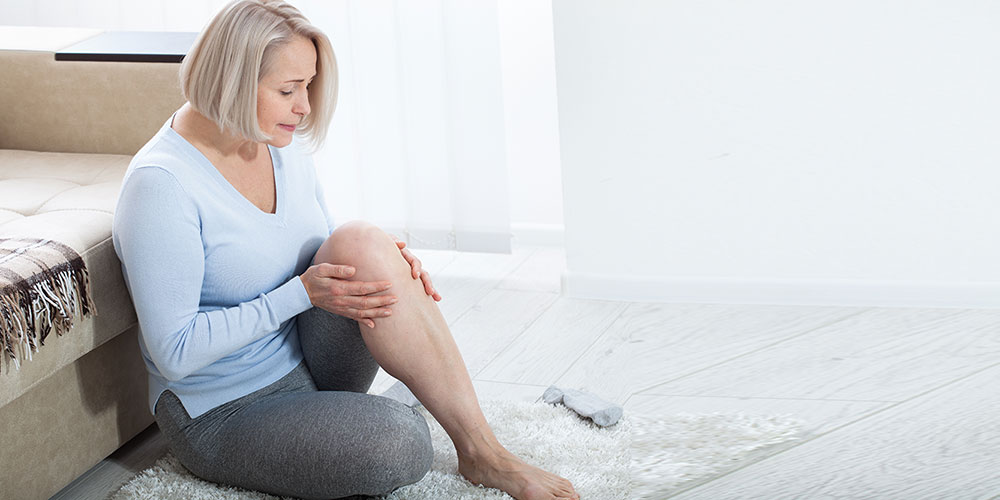Make an Appointment
The third trimester (along with every stage of pregnancy) is hard on the body. But exercise and working with a Women’s Health Physiotherapist can help!
Still, everyone is different and every pregnancy is different. But, after speaking with your doctor, it may be perfectly safe to exercise during your third trimester and there are many benefits to doing so.
Here, we’re talking about what you can expect during your third trimester of pregnancy and some physiotherapy exercises during third trimester of pregnancy for normal delivery.
What to Expect During Third Trimester of Pregnancy
How many weeks is your third trimester of pregnancy? Well, the third trimester is only between 12 to 14 weeks long. However, since you’re coming towards the end of your pregnancy in the third trimester, it can seem like it lasts for much longer.
Your body will feel ready to get your baby out into the world, so time can seem to be moving more slowly. Plus, you might be in more pain and discomfort during the third trimester causing time to drag.
During the third trimester, you can expect to experience some or all of the following:
- Feeling large and heavy as your baby does most of its growth during the third trimester
- Abdominal achiness, cramps, and sharp pains as your round ligaments stretch to accommodate your baby
- Fatigue due to all your baby’s growth and the extra weight you’ll be carrying
- Heartburn as your stomach is pushed upwards
- Braxton Hicks contractions as your body prepares for labour
- Varicose veins due to inhibited blood circulation
- Stretch marks as your skin stretches to accommodate your baby
- Backaches since the pregnancy hormone called relaxin will loosen your joints pulling your centre of gravity forward
- Poor bladder control due to the extra pressure put on your pelvic floor during the third trimester
- Leaky breasts as your body prepares to breastfeed
Again, you may not experience all of these symptoms during the third trimester but many are common. The good news is that exercise and working with a Women’s Health Physio can help.
Common Concerns During the Third Trimester
Many Women’s Health Physiotherapists see three common concerns in women during the third trimester of pregnancy:
- Pelvic girdle pain
- Upper back and rib pain
- Pelvic floor weakness (bladder leaking)

Below, we’ll show you how physiotherapy can help during the third trimester to relieve these common pains through gentle exercises.
How Can Physiotherapy Help in the Third Trimester
Many women find that working with a physio throughout pregnancy can help in numerous ways. Some of the most common benefits of physiotherapy during pregnancy include:
- Learning how to push during labour
- Lengthening and strengthening pelvic muscles to reduce pain
- Practising labour positions
- Practising relaxation techniques
- Prevention of urinary incontinence
- Relieving back pain
- Relieving sexual intercourse pain
So, let’s get into the specifics of managing the most common third-trimester concerns.
Pelvic Girdle Pain
Many women experience pain in the front, back or side of the pelvis (pelvic girdle) in the third trimester. Pain is usually worse when walking, upstairs or crossing legs.
Tips for Pelvic Girdle Pain
Try to keep your legs moving together! So, take smaller steps and avoid crossing your legs. Reduce single leg exercises like step-ups and lunges in the gym as well.
- Sleep on your side with a pillow between the knees to keep the hips stacked evenly
- Try double leg strengthening exercises such as mini squats and glute bridges as pain allows
- A pelvic support belt may be an option to reduce pain when walking
- Chat to your physiotherapist for specific exercises and belt options for each individual
Upper Back and Rib Pain
As your baby and your belly are growing and expanding, the ribs expand and change the way we move in our upper back. This can limit our rotation or twisting movements and make us feel that our posture is pulling forward.
Tips for Upper Back and Rib Pain
- Try to keep your shoulders back when possible
- Practice gentle rotation stretches as prescribed by a physio
- Heat, massage and trigger ball release can be really helpful
Pelvic Floor Weakness
As the weight of the uterus and baby is increasing, the pressure placed on the bladder and pelvic floor increases.
This can lead to urge incontinence (feeling the need to pass urine very often or feeling that you may not make it to the bathroom) or stress incontinence (leaking urine on a cough, sneeze or jump).
Tips for Pelvic Floor Weakness and Bladder Leakage
- Pelvic Floor Exercises – strengthening the pelvic floor is important to reduce risks of complications in labour and after delivery such as prolapse and incontinence. A Women’s Health Physiotherapist can give a pelvic floor exercise program.
- Practice good bladder habits - not going when you don’t need to go, trying to hold and not rush to the bathroom (but not holding for too long!)
Exercise in the Third Trimester
Exercise intensity should start to decrease in the third trimester. High impact exercises like jumping and running will be replaced by lower intensity such as walking, yoga, gentle Pilates and bodyweight strength training.
Swimming and water-based exercise are great options for those experiencing any joint pain when walking. Pelvic floor and gentle core exercises are important in the third trimester as well to improve outcomes for recovery after delivery.
Stretching exercises during third trimester for a normal delivery are also important.
To give you a breakdown of what exercises to do during your third trimester, here are a few pregnancy exercises that are generally physio approved:
- Child’s pose to help relieve back pain
- Kegels to strengthen your pelvic floor in preparation for delivery
- Walking and jogging to help improve your mood and cardiovascular health
- Deep squats to help stretch your body and prepare for delivery
- Swimming and water aerobics as cardio exercises that are gentle on your joints
- Cat/cow (to be done on all-fours) can also help alleviate back pain
- Low impact works like prenatal yoga, barre, and Pilates are all wonderful exercises to try during your third trimester
- Perineal bulges, which are the opposite of Kegels, helps you practise pushing without holding your breath
- Perineal massage also helps prepare your pelvic area for delivery and, if you’re comfortable, can be done on your own or by your doctor

Preparing for Exercise During the Third Trimester
Aside from knowing how to exercise during your third trimester, there are a few things to keep in mind to get prepared to start your safe pregnancy exercise routine. Here are a few things to do before you start exercising in the third trimester:
- Choose loose, comfortable clothing to ensure you’re not cutting off any circulation
- Control the temperature either by avoiding exercise outdoors or by using the aircon to make sure you stay cool as overheating can harm the baby
- Drink plenty of water to ensure hydration
- Wear comfortable footwear to make sure you’re stable and won’t fall
- If you’re too fatigued, there’s no need to over-exert yourself -- feel free to rest
- Avoid standing for too long which can cause the lower limbs to swell
Exercise to Avoid During the Third Trimester
As a rule of thumb, during the third trimester of pregnancy you’ll need to avoid:
- Jumping, hopping, skipping, or bouncing
- Crunches and ab work that requires lying on your back
- Heavy weight-lifting (in general, bodyweight exercises are best)
- Exercises that excessively increase your body temperature
Always gain approval from a medical professional before exercising during pregnancy, as some conditions may mean exercise is not safe for mother or baby.
Benefits of Exercise During the Third Trimester
Overall, exercise is an important part of a healthy lifestyle and healthy mums mean healthy babies.
Although it’s always important to consult with your doctor about how to safely exercise during pregnancy based on your unique circumstances, overall, there are many benefits of exercising during every stage in your pregnancy.
Doing low-impact exercises during the third trimester produces amazing health benefits such as:
- Better cardiovascular fitness
- Regulated blood pressure
- Improved mood
- Weight control
Let’s face it -- being pregnant is tough. So, exercise can help make it better. By exercising safely during the third trimester, you’re preparing yourself for the intensity of labour and you’re improving your outlook on life through the aches and pains of your quickly changing body.
Plus, sticking with an exercise routine, however simple, will help you continue with these healthy exercise habits post-pregnancy. After all, the post-natal period is just as tough, if not more so. Knowing how to give yourself some me-time through exercise after your baby is born is super important.
At Physio Inq, our expert Women’s Health Physiotherapists are ready to provide you with the advice, training, and garments to manage pain and weakness in pregnancy. Remember that you can do something about it!
Contact us today for a Women’s Health Physio appointment in one of our private rooms or take advantage of our mobile physio services that can bring us to you.
Additional Resources
- Can I exercise During Early Pregnancy?
- When Should I Start To Exercise After My Pregnancy?
- Pregnancy 101 – How Your Body Changes During Pregnancy
- 10 Ways To Decrease Pelvic Pain In Pregnancy
Date Published: Wednesday, March 17, 2021
Locate a Women's Health
Service Near me
Get the experience & convinence you deserve to support your or a loved one's allied health needs.
Our Women's Health team are currently serving & taking appointments in the following states and regions in Australia:
Need to get into direct contact with ur Client Services team? We're all ears. Call our team directly on 1300 731 733







